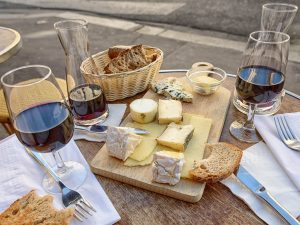
Many wine consumers believe that any sweet wine must be dry if it has to be served with savory foods. This is so because they tend to associate sweetness with fortified wines, German wines, or cheap jug wines (except dessert wines), which, according to many people, should be drunk with dessert or after dessert.

Ranging from luscious to barely sweet, sweet white wines can gloriously be served with food. The major secret here is balance (the sugar residue that results from incomplete wine fermentation must be neutralized with lively acidity). Since sweet wines have to tread the line between dry and sweet, the result is even a thrilling tightrope walk in successful bottles. Indisputably, these wines are sweet, but since their acidity content eliminates a cloying sensation, they leave you with a dry, refreshing feeling once you have swallowed them.
Example:
Classic examples can be found in certain demi-sec Vouvrays and German Rieslings (all German Rieslings are sweet- this is just another myth anyway). On one occasion, Josh MacGregor of DB Bistro Modern picked Dr. Loosen Spatlese (a 2015 Riesling) and J.J. Prum Kabinett (a 2017 Riesling) from Wehlener Sonnenuhr for a foie gras and guinea hen terrine course. This decision somehow stacked the deck since foie gras is traditionally served with excessively sweet wines (e.g. Sauternes). Even so, many diners were not persuaded by Josh’s selection. After the dinner, one of the diners had to remark as follows:
“People are stuck on the fact that they don’t like sweet wines. I don’t understand that. We’re such a sweet culture.”




